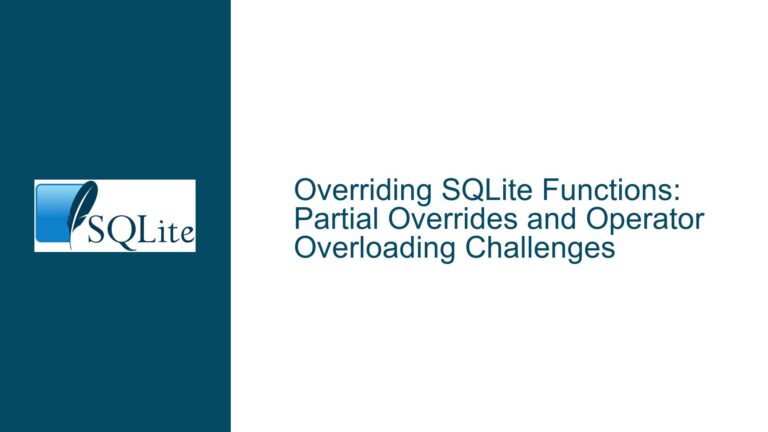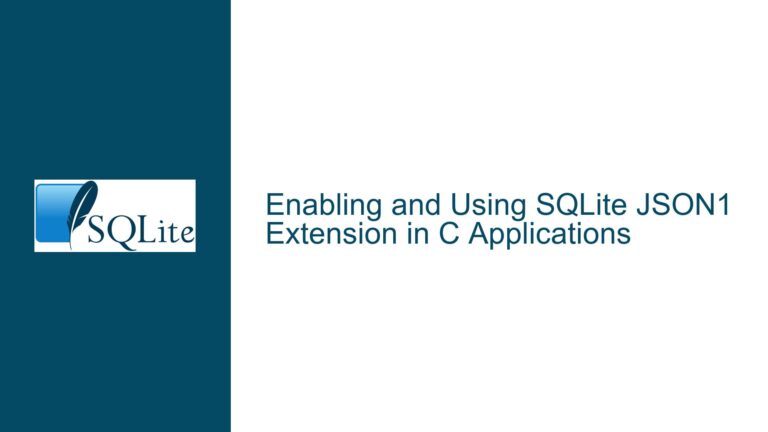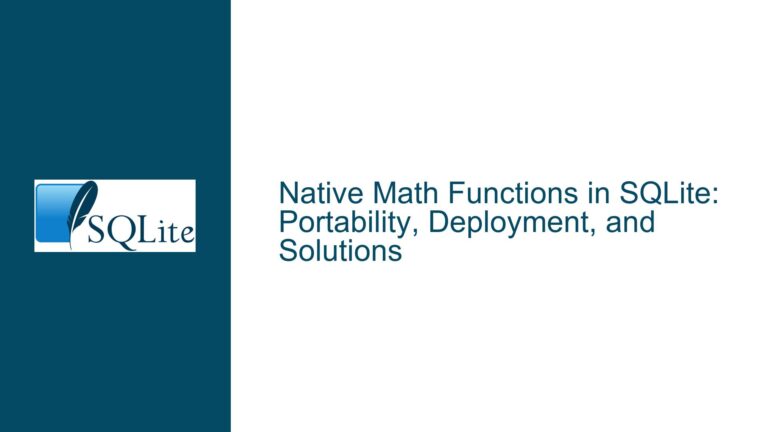Segmentation Fault in SQLite CLI Due to NULL Pointer in strlen()
Issue Overview: Segmentation Fault in SQLite CLI When Executing EXPLAIN QUERY PLAN with .limit le 0
The core issue revolves around a segmentation fault (segfault) occurring in the SQLite Command-Line Interface (CLI) when executing a specific sequence of commands. The fault is triggered by a combination of creating a table, setting a limit using .limit le 0, and then running an EXPLAIN QUERY PLAN statement. The segfault is caused by a strlen() function call attempting to read from a NULL pointer, which is a direct violation of memory safety principles. This issue is isolated to the SQLite CLI and does not affect the core SQLite library.
The stack trace reveals that the fault originates in the eqp_append function within the CLI’s shell.c file. The eqp_append function is responsible for appending text to the EXPLAIN QUERY PLAN output. When the .limit le 0 command is executed, it appears to interfere with the memory allocation or string handling mechanisms, leading to a situation where zText is NULL when passed to strlen(). This results in a segmentation fault, as strlen() cannot operate on a NULL pointer.
The issue was traced back to a specific Fossil commit (c33a275bf1a0ea10) from 2015-11-02, but it only became apparent in SQLite 3.39.0. The bug was promptly fixed in the trunk version of SQLite, with the root cause identified as a CLI-specific issue rather than a problem with the core SQLite library.
Possible Causes: Memory Allocation Failure and NULL Pointer Dereference in CLI
The segmentation fault is primarily caused by a NULL pointer dereference in the SQLite CLI. The eqp_append function, which is part of the CLI’s implementation of EXPLAIN QUERY PLAN, attempts to call strlen() on a NULL pointer (zText). This occurs under specific conditions related to memory allocation and the .limit le 0 command.
Memory Allocation Failure
The .limit le 0 command sets the maximum length of a string to zero, which can lead to memory allocation issues. When the CLI attempts to allocate memory for the EXPLAIN QUERY PLAN output, it may fail due to the zero-length constraint. This failure can result in a NULL pointer being assigned to zText, which is subsequently passed to strlen().
NULL Pointer Dereference
The strlen() function is designed to operate on valid C-style strings (null-terminated character arrays). When passed a NULL pointer, strlen() attempts to read from memory address 0x00000000, which is an invalid operation and triggers a segmentation fault. This behavior is consistent with the stack trace and the UndefinedBehaviorSanitizer (UBSAN) report, which indicates a "READ memory access" error at address 0x000000000000.
Interaction Between .limit le 0 and EXPLAIN QUERY PLAN
The .limit le 0 command modifies the internal state of the CLI, specifically the maximum allowed string length. When combined with EXPLAIN QUERY PLAN, this modification interferes with the CLI’s ability to generate and append text to the query plan output. The eqp_append function assumes that zText is a valid pointer, but the .limit le 0 command can cause zText to be NULL, leading to the segmentation fault.
Historical Context
The bug traces back to a Fossil commit from 2015, but it remained latent until SQLite 3.39.0. This suggests that changes in the CLI’s memory handling or string processing logic in version 3.39.0 exposed the issue. The fix in the trunk version of SQLite addresses this by ensuring that zText is never NULL when passed to strlen().
Troubleshooting Steps, Solutions & Fixes: Diagnosing and Resolving the Segmentation Fault
Diagnosing the Issue
To diagnose the segmentation fault, follow these steps:
Reproduce the Issue: Execute the following commands in the SQLite CLI:
CREATE TABLE t0(b); .limit le 0; EXPLAIN QUERY PLAN SELECT * FROM t0;Observe whether the CLI crashes with a segmentation fault.
Analyze the Stack Trace: If the CLI crashes, capture the stack trace using a debugger (e.g.,
gdb). The stack trace should point to theeqp_appendfunction in shell.c, withstrlen()attempting to read from aNULLpointer.Enable Sanitizers: Compile SQLite with UndefinedBehaviorSanitizer (UBSAN) to detect memory safety violations. The sanitizer report should indicate a "READ memory access" error at address
0x000000000000.Check CLI Version: Verify the SQLite CLI version using the
.versioncommand. The issue is present in SQLite 3.39.0 but may not occur in earlier versions.
Resolving the Issue
The following solutions and fixes address the segmentation fault:
Update to the Latest Version: The bug has been fixed in the trunk version of SQLite. Update to the latest version to resolve the issue. The fix ensures that
zTextis neverNULLwhen passed tostrlen().Modify the CLI Code: If updating is not feasible, modify the CLI code to handle
NULLpointers safely. Replace thestrlen()call withsqlite3Strlen30(), which is a safer alternative that checks forNULLpointers:int len = sqlite3Strlen30(zText);This change prevents the segmentation fault by avoiding the dereference of a
NULLpointer.Avoid .limit le 0: As a workaround, avoid using the
.limit le 0command in conjunction withEXPLAIN QUERY PLAN. This prevents the CLI from entering a state wherezTextcould beNULL.Improve Error Handling: Enhance the CLI’s error handling to detect and recover from memory allocation failures. For example, check the return value of memory allocation functions and handle
NULLpointers gracefully.
Long-Term Best Practices
To prevent similar issues in the future, adopt the following best practices:
Use Safer String Functions: Replace unsafe C standard library functions (e.g.,
strlen(),strcpy()) with safer alternatives (e.g.,sqlite3Strlen30(),sqlite3_snprintf()). These functions include checks forNULLpointers and buffer overflows.Enable Sanitizers During Development: Compile SQLite with sanitizers (e.g., UBSAN, ASAN) during development to detect memory safety violations early.
Thoroughly Test Edge Cases: Test the CLI with edge cases, such as zero-length strings and maximum string lengths, to identify and fix latent bugs.
Review Historical Bugs: Analyze historical bugs and their fixes to identify patterns and prevent regressions. For example, the bug traced back to a 2015 commit highlights the importance of reviewing older code for potential issues.
By following these troubleshooting steps, solutions, and best practices, you can effectively diagnose, resolve, and prevent segmentation faults in the SQLite CLI.






